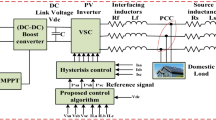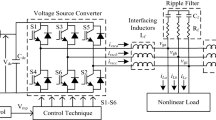Abstract
The power quality of the grid-coupled photovoltaic system (GCPVS) is enhanced using a control scheme developed by employing a robust generalized soft-root-sign (GSRS) adaptive filter. Power quality (PQ) deterioration issues are common in the distribution grid due to the mix of irregular loads. The GSRS control scheme mitigates harmonics, compensates load unbalances, achieves unity power factor at the grid, and compensates load reactive power, thus leading to balanced sinusoidal currents at the grid side. The GSRS algorithm utilizes a soft-root-sign cost function to achieve less steady-state misalignment while estimating magnitudes of fundamental frequency load current components for PQ improvement. The designed single-stage GCPVS performs smooth power flow between local loads and the grid without necessitating an energy storage system. The control scheme initially meets load demand and then sends any surplus power to the grid. However, if the generated PV power falls below the load demand due to environmental conditions, the additional power for the load is drawn from the grid. Moreover, voltage source converter used in the GCPVS also provides the functionality of DSTATCOM, thus avoiding the usage of additional equipment. The proposed GSRS control scheme and the GCPVS are modeled in MATLAB/Simulink. A laboratory-designed experimental setup is used to carry out the experimental validation of the GSRS control scheme and found to be performing satisfactorily. The behavior of GCPVS is verified during steady-state and dynamic conditions. The GCPVS performance is verified with the standard IEEE-519-2022, and a comparison of the GSRS algorithm with other filtering algorithms is provided.
















Similar content being viewed by others
References
Kumar S, Saket RK, Dheer DK, Holm-Nielsen JB, Sanjeevikumar P (2020) Reliability enhancement of electrical power system including impacts of renewable energy sources: a comprehensive review. IET Gener Transmiss Distrib 14(10):1799–1815
Ullah S, Haidar AMA, Zen H (2020) Assessment of technical and financial benefits of AC and DC microgrids based on solar photovoltaic. Electr Eng 143:1–14
Elgendy M, Atkinson D, Zahawi B (2016) Experimental investigation of the incremental conductance MPPT algorithm at high perturbation rates. IET Renewable Power Gener 10(2):133–139
Killi M, Samanta S (2015) Modified perturb and observe MPPT algorithm for drift avoidance in photovoltaic systems. IEEE Trans Ind Electron 62(9):5549–5559
Bollipo RB, Mikkili S, Bonthagorla PK (2021) Hybrid, optimal, intelligent and classical PV MPPT techniques: a review. CSEE J Power Energy Syst 7(1):9–33
Kumar V, Ghosh S, Naidu NKS, Kamal S, Saket RK, Nagar SK (2021) Load voltage- based MPPT technique for standalone PV systems using adaptive step. Int J Electr Power Energy Syst 128:106732
Wu TF, Chang CH, Lin LC, Kuo CL (2011) Power loss comparison of single- and two-stage grid-connected photovoltaic systems. IEEE Trans Energy Convers 26(2):707–715
Singh B, Chandra A, Al-Haddad K (2015) Power quality problems and mitigation techniques. Wiley, Hoboken, pp 96–158
Youssef TA, Mohammed O (2013) Adaptive SRF-PLL with reconfigurable controller for microgrid in grid-connected and stand-alone modes. In: Proc. IEEE Power Energy Soc. Gen. Meeting, pp. 1–5
Suárez JH, Gomes HM, Filho AJS, Fernandes DA, Costa FF (2020) Grid impedance estimation for grid-tie inverters based on positive sequence estimator and morphological filter. Elect Eng 102:1195–1205
Guo B, Bacha S, Alamir M, Hably A, Boudinet C (2021) Generalized integrator-extended state observer with applications to grid-connected converters in the presence of disturbances. IEEE Trans Control Syst Technol 29(2):744–755
Ahmed H, Benbouzid M (2020) ‘On the enhancement of generalized integrator-based adaptive filter dynamic tuning range. IEEE Trans Instrum Meas 69(10):7449–7457
Bamigbade A, Khadkikar V (2022) Frequency estimators for SOGI FLL: Modeling, design, and equivalence for FLL advancements. IEEE Trans Instrum Meas 71:9006212
Pan X, Zhang L, Huang H (2022) Harmonic cancellation by adaptive notch filter based on wavelet package transform for an MMCC-STATCOM. IEEE Trans Power Del 37(3):1834–1844
Haykin SS (2008) Adaptive filter theory. Pearson Education India, India
Kumar K, Pandey R, Karthik MLNS, Bhattacharjee SS, George NV (2021) Robust and sparsity-aware adaptive filters: a review. Signal Process 189:108276
Pradhan S, Hussain I, Singh B, Panigrahi BK (2017) Modified VSS-LMS-based adaptive control for improving the performance of a single-stage PV-integrated grid system. IET Sci Meas Technol 11(4):388–399
Agarwal RK, Hussain I, Singh B (2016) LMF-based control algorithm for single stage three-phase grid integrated solar PV system. IEEE Trans Sustain Energy 7(4):1379–1387
Gui G, Adachi F (2015) Adaptive sparse system identification using normalized least-mean fourth algorithm. Int J Commun Syst 28(1):38–48
Patel N, Kumar A, Pota HR, Bansal RC, Gupta N (2023) Adaptive qXE-LMF filter for improving power quality using grid-supporting photovoltaic system. IEEE Syst J 17(2):2709–2720
Badoni M, Singh A, Singh AK, Saxena H, Kumar R (2023) Grid tied solar PV system with power quality enhancement using adaptive generalized maximum versoria criterion. CSEE J Power Energy Syst 9(2):722–732
Singh S, Kewat S, Singh B, Panigrahi BK, Kushwaha MK (2021) A multifunctional three phase grid coupled solar PV energy conversion system using delayed µ-law proportionate control for PQ improvement. IEEE Trans Ind Appl 58(1):554–564
Wang S, Wang W, Xiong K, Iu HHC, Tse CK (2021) Logarithmic hyperbolic cosine adaptive filter and its performance analysis. IEEE Trans Syst Man Cybern Syst 51(4):2512–2524
Yoo J, Shin J, Park P (2015) ‘Variable step-size sign algorithm against impulsive noises. IET Signal Process 9(6):506–510
Sayin MO, Vanli ND, Kozat SS (2014) A novel family of adaptive filtering algorithms based on the logarithmic cost. IEEE Trans Signal Process 62(17):4411–4424
Shah P, Hussain I, Singh B (2018) Real-time implementation of optimal operation of single-stage grid interfaced PV system under weak grid conditions. IET Gener Transm Distrib 12(7):1631–1643
Patel V, Bhattacharjee SS, Christensen MG (2023) Generalized soft-root-sign based robust sparsity-aware adaptive filters. IEEE Signal Process Lett 30:200–204
Karthik M, Naik NVR, Panda AK (2022) A variable step size robust normalized least mean absolute third-based control scheme for a grid-tied multifunctional photovoltaic system. Int J Circuit Theory Appl. https://doi.org/10.1002/cta.3618
Naqvi SQ, Singh B (2022) A PV-battery system resilient to weak grid conditions with regulated power injection and grid supportive features. IEEE Trans Sustain Energy 13(3):1408–1419
Subudhi B, Pradhan R (2013) A comparative study on maximum power point tracking techniques for photovoltaic power systems. IEEE Trans Sustain Energy 4(1):89–98
“IEEE standard for harmonic control in electric power systems. in IEEE Std 519–2022 (Revision of IEEE Std 519–2014), pp. 1–31, 5, 2022.
Author information
Authors and Affiliations
Contributions
MK was involved in conceptualization, methodology, formal analysis and investigation, and writing—original draft preparation. NVRN was involved in formal analysis and investigation. AKP was involved in review and editing. All authors reviewed the manuscript.
Corresponding author
Additional information
Publisher's Note
Springer Nature remains neutral with regard to jurisdictional claims in published maps and institutional affiliations.
Rights and permissions
Springer Nature or its licensor (e.g. a society or other partner) holds exclusive rights to this article under a publishing agreement with the author(s) or other rightsholder(s); author self-archiving of the accepted manuscript version of this article is solely governed by the terms of such publishing agreement and applicable law.
About this article
Cite this article
Karthik, M., Naik, N.V.R. & Panda, A.K. A robust generalized soft-root-sign adaptive filter algorithm for a grid-coupled PV system. Electr Eng 106, 2537–2553 (2024). https://doi.org/10.1007/s00202-023-02097-7
Received:
Accepted:
Published:
Issue Date:
DOI: https://doi.org/10.1007/s00202-023-02097-7




